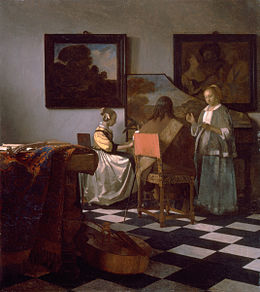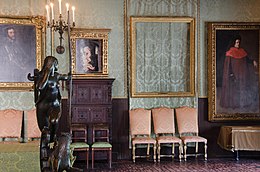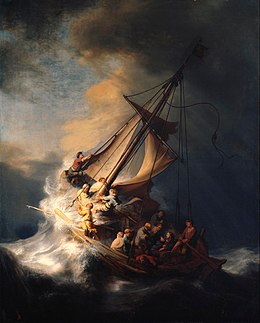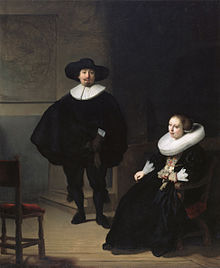Isabella Stewart Gardner Museum theft
The Boston art heist was committed in the early morning of March 18, 1990. Thirteen works of art were stolen from the collection of the Isabella Stewart Gardner Museum in Boston, Massachusetts. The museum's night guards were taken by surprise by two perpetrators dressed as police officers who had ostensibly appeared at the museum in response to a complaint of disturbance. They tied up the guards and, in just under an hour and a half, took possession of the artwork on display in three different rooms of the museum. The Federal Bureau of Investigation (FBI) has put the value of the loot at $500 million. This makes the Boston art heist the art theft with the most valuable loot in criminal history. Despite extensive search measures at home and abroad, neither the perpetrators could be identified nor parts of the loot recovered. The museum has now offered a reward of 10 million US dollars for information leading to the recovery of the artworks. This is the highest reward ever offered by a private institution.
The stolen artworks were part of Isabella Stewart Gardner's private art collection, which has been on public display in the museum named after her since 1903. Since Gardner's death in 1924, the collection has been managed by a foundation. The donor stipulated that the artworks be presented in the manner she determined, without any alteration. This also excluded sales and acquisitions. Out of respect for the founder's will, the empty picture frames have been on the walls since the robbery as a reminder of the missing works and as placeholders for their expected return.
Among the stolen artworks is The Concerto, one of only about three dozen surviving works by Dutch painter Jan Vermeer. This painting is considered the most valuable lost painting in the world. Rembrandt's only seascapes, Christ in a Storm on the Sea of Galilee, is also among the loot, as are his Portrait of a Married Couple and an etched self-portrait in small format. His self-portrait with feathered beret, however, was left behind. Other looted artworks include works by Degas, Manet and Flinck, as well as an aigle de drapeau and a ku, a Chinese ritual bronze vessel. The selection of looted objects seems puzzling, as the less valuable looted pieces are juxtaposed with a number of important works of art that were left behind at the museum.
The FBI classifies the robbery as organized crime. Investigators based their work on the interrogation of witnesses and suspects, the use of undercover agents and sting operations because of the lack of traces of the perpetrators. The initial investigation was into one of the overpowered security guards who had been acting suspiciously in the hours leading up to the robbery. James "Whitey" Bulger, as boss of the Winter Hill Gang, was one of the most prominent organized crime figures in the Greater Boston metropolitan area at the time of the robbery. His known contacts with the Boston police and with the Irish-born Boston underworld made him a suspect. Another trail led to Carmello Merlino's gang in Dorchester, a Boston neighborhood. Merlino and his gang were part of the Patriarca family environment that dominated the Boston and New England underworld in the decades before the art heist. Some of the gang members were jailed as part of a sting operation. Although they were promised money, reduced prison sentences, and even immunity from prosecution, the suspects denied the crime or gave only useless tips.
Another target of the investigation was the part of the Patriarca family known as the Boston Mafia, which was involved in a gang war at the time of the robbery. Boston gangster Bobby Donati, who was murdered a year and a half after the robbery, was considered the prime suspect. Donati, according to one theory, committed the robbery to free his capo Vincent Ferrara. Ferrara was a high-ranking member of the Patriarca family, was in custody. He was charged eight days after the robbery, along with boss Raymond Patriarca, Jr. and other prominent members of the family, with extortion, racketeering, illegal gambling, drug trafficking and murder.
Thirty years after the heist, the loot is still missing. The Isabella Stewart Gardner Museum and the Federal Bureau of Investigation are making irregular public appearances, with the goal of recovering the artwork rather than identifying the perpetrators, given the statute of limitations on the heist.

Édouard Manet: Chez Tortoni

Jan Vermeer: The Concerto

The empty frame of Rembrandt's Christ in the Storm on the Sea of Galilee

Rembrandt: Christ in the Storm on the Sea of Galilee
Background
Open to the public since 1903, the Isabella Stewart Gardner Museum was commissioned by art collector Isabella Stewart Gardner to house her private art collection. Gardner expanded the collection and designed the museum's rooms until her death in 1924. She placed the museum and $3.6 million in an endowment, stipulating that the arrangement of the artworks not be altered and that the size of the collection not be changed by sales or purchases.
At the beginning of the 1980s, the museum was in a difficult financial situation. As a result, the museum building lacked the necessary maintenance, lacked air conditioning, and lacked adequate insurance for the art objects. In 1982, the Federal Bureau of Investigation (FBI) uncovered a planned art heist at the museum. The museum then invested in improved security measures. These included sixty motion detectors inside and a video surveillance system with four cameras outside the building. Video surveillance of the interior rooms was dispensed with for cost reasons. The security staff was also increased. The only way to trigger an alarm was an alarm button in the security control room. Other museums at the time already had a security system that included hourly messages from the night watch.
In 1988, an independent security consultant found that the Isabella Stewart Gardner Museum's security measures were equivalent to those of most other museums. However, he recommended improvements. The director of security for the Museum of Fine Arts in Boston also suggested improved security measures for the Gardner Museum. In view of the tight financial situation and in deference to the donor's desire not to make major changes, the proposed security measures were rejected by the Board of Trustees. The board also rejected the security officer's demand for better pay for the guards, through which he wanted to attract better qualified personnel. At the time, security guards were paid little more than minimum wage. The security deficiencies were considered an open secret among the guards.

The Gardner Museum, 2018. main entrance on the left, Palace Road side entrance on the right.
Raid
The attack occurred in the early hours of March 18, 1990, a Sunday. The previous day was Saint Patrick's Day, which was celebrated extensively and into the night in the city with its many Irish-born residents. The two robbers were first spotted around 0:30 a.m. by returning guests at a party near the museum. They were dressed as police officers and parked in Palace Road, only about thirty yards from the side entrance of the museum. Witnesses mistook them for real police officers.
The museum's night guard consisted of two security guards, 23-year-old Rick A. and his 25-year-old colleague Randy H., who was assigned to the night shift for the first time. Security protocol called for one guard at a time to make a tour of the museum's rooms with a flashlight and walkie-talkie while his colleague remained in the security office. The younger but more experienced Rick was the first to go on the rounds. During his patrol, the fire alarm went off in several rooms of the museum, but he could detect no fire or smoke. He returned to the security control panel and found reports of smoke in several rooms of the museum on the fire alarm system control panel. Believing it was a malfunction, he turned off the fire alarm system. Rick A. continued his rounds, briefly opening and closing the side entrance, without informing his colleague Randy H. He then went back to the museum. He finished his rounds around 01:00 early Sunday morning, whereupon Randy H. resumed his rounds.
At approximately 01:20, the offenders pulled up at the side entrance and went to the door. They rang the bell and were connected to Rick A. via the intercom. They explained to him that they were following up on a report of a disturbance and needed entry. The security guard could see the two individuals through the video system and mistook them for police officers because of their uniforms. He was unaware of any disturbance, but believed that perhaps one of the night's revelers had climbed over the fence and been reported to police by a witness. At 01:24, the perpetrators gained access to the museum.
The perpetrators were first admitted to the foyer, which was separated from the exhibition rooms and contained the entrance to the security control centre. They approached the security guard Rick A., who was in the adjacent security center, and asked if there were other employees in the museum. At the request of the alleged police officers, Rick called his colleague over the walkie-talkie to the control center. At about this time, the security guard noticed that the mustache of one of the visitors appeared to be a false beard. The smaller of the two perps told Rick that he looked familiar and that there might be a warrant out for his arrest. He was told to come forward and show his identification. Rick followed the instruction and thus removed himself from his place of employment with the only available alarm button. The smaller robber pushed the guard up against the wall and handcuffed him without searching him. Meanwhile, the second guard entered the room and was also handcuffed by the larger offender. The perpetrators then revealed their true intentions to the guards and told them not to cause them any problems.
Duct tape was wrapped around the guards' heads and over their eyes. The perpetrators, who apparently knew the area, led them into the basement, where the guards were tied to a heating pipe and a workbench. The robbers searched the guards' wallets, explaining that they knew where they lived and that they should not tell the authorities. If they kept quiet, they would receive a reward in about a year. Overpowering the guards took eleven minutes, until 01:35.
The subsequent path of the robbers through the exhibition rooms was recorded by the motion detectors. It was not until 01:48, thirteen minutes after the guards had been tied up, that the first recording was made in the Dutch Room on the first floor. Possibly the robbers waited first, in case an alarm had been triggered.
When the robbers approached the paintings in the Dutch Room, an acoustic signal was triggered. This device was supposed to warn if visitors got too close to one of the paintings in the museum. The robbers smashed the device and took Rembrandt's Christ in a Storm on the Sea of Galilee and his Portrait of a Married Couple off the wall. They threw the two paintings onto the stone floor, shattering the glass of the frames. With a sharp blade, they cut the paintings out of the frames. They also took Rembrandt's Self Portrait with Feathered Beret off the wall and leaned it against a cabinet with the picture side facing the wall, where they left it. Investigators later felt that the painting, which unlike the other two Rembrandts was painted on wood, had seemed too bulky for the robbers to transport. An alternative explanation is that it was left behind in the rush and excitement of the robbery, as from the back, the deposited painting had appeared to be a frame with an old wooden backing and the canvas ripped out. Instead, the perpetrators robbed a postage stamp-sized etching of Rembrandt, a self-portrait that had hung below the large self-portrait. On the right wall of the room, they took down Landscape with an Obelisk by Govaert Flinck and The Concerto by Vermeer and removed them from their frames as well. The last piece of loot from this room was a ku, a Chinese ritual bronze vessel of the Shang dynasty (11th or 12th century BC).
At 01:51 one of the robbers entered the Short Gallery, a narrow corridor at the other end of the first floor. His accomplice initially stayed in the Dutch Room, but followed him after a short while. They tampered with the screws of a display in which was exhibited a gilt bronze aigle de drapeau with a troop flag of the 1er régiment de grenadiers à pied de la Garde impériale. Before all the bolts were removed, they desisted from the display, but took the standard eagle attached to the end of the flagstaff. They also stole five drawings by Edgar Degas from this room. The last work stolen was Chez Tortoni, an oil painting by Édouard Manet displayed in the Blue Room on the ground floor. During the heist, no movement was registered in the Blue Room by the motion sensors. The only movements recorded in the room during the night of the robbery were two rounds by a security guard.
At the end of the robbery, the perpetrators went to the basement and inquired about their condition with the security guards. They then went to the office of the head of the security service and took the recording tapes of the video surveillance and the automatically printed logs of the motion detectors. The data from the motion detectors were also recorded on a hard drive and were later available to investigators to reconstruct the course of the crime. The perpetrators left the frame of the painting Chez Tortoni on the desk of the manager. They then removed their loot from the museum. For this purpose, the door of the side entrance was opened twice, at 02:40 and at 02:45. The robbery lasted from the moment of entrance of offenders into the building till their departure 81 minutes.
The early shift security guards who arrived in the morning were unable to gain access to the building and called the head of security, who used his key to gain entry. When he found the security office deserted, he notified the police. While searching the building, police officers found the security guards still tied up in the basement.
,_China,_Shang_dynasty,_bronze,_Honolulu_Academy_of_Arts.JPG)
Ku, ritual bronze vessel of the Shang dynasty (similar object)

Rembrandt: Portrait of a Married Couple

Govaert Flinck: Landscape with an obelisk

Rembrandt: Self Portrait with Soft Cap
Search within the encyclopedia